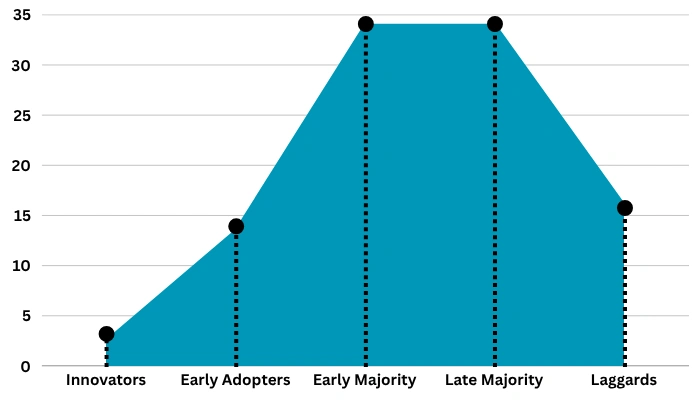The marketing bell curve is a simple graph that shows how different types of people adopt a new product or service over time. It looks like a hill or a “bell” shape and helps businesses understand their customers better.
Here is the bell curve meaning in very simple words:
Want more patients for your new dental services?
We use smart marketing strategies like the bell curve to get real results.

How the Marketing Bell Curve Works in Dentistry?
When dentists introduce a new treatment, technology, or service, not all patients are ready to accept it right away. Some are super excited, some take time, and some may never show interest.
This is where the Marketing Bell Curve helps. It shows how different groups of patients adopt new dental services over time, so you can plan your marketing and communication efforts wisely.
The 5 Patient Segments in Dentistry (Based on the Bell Curve)

1. Innovators (First 2.5%)
2. Early Adopters (13.5%)
Marketing Tip: Use patient testimonials, before-and-after photos, and highlight benefits clearly on social media or the website. Hire a dental marketing expert for this task.
3. Early Majority (34%)
4. Late Majority (34%)
Marketing Tip: Focus on patient education , flyers, WhatsApp broadcasts, and polite reminder calls work well.
5. Laggards (16%)
What Are the Limitations of a Marketing Bell Curve?
Even though the bell curve is helpful, it has some downsides:
Marketing Bell Curve vs. Non-Normal Distributions
Now let’s compare it with non-normal distributions (when adoption does not follow the hill pattern):
| Feature | Marketing Bell Curve | Non-Normal Distribution |
| Shape | Bell-shaped (symmetrical) | Irregular, can be flat or uneven |
| Adoption Flow | Smooth and predictable | Can be sudden or very slow |
| Best For | General markets and stable products | Niche, viral, or rapidly changing markets |
| Example | Washing machines, mobile phones | Viral apps, limited-edition products |
For Example
Let’s say you are launching a new toothpaste. Most people (early & late majority) will start using it after a few reviews and ads. That’s a bell curve.
Now, imagine you launch a limited-edition meme-based toothpaste. It goes viral overnight on TikTok. That’s a non-normal distribution, fast, unpredictable, and doesn’t follow the “hill” pattern.
Bell Curve in Dental Team Performance & Appraisals
Using the Bell Curve for Staff Reviews
Many large clinics and hospitals use the bell curve to evaluate employee performance:
However, this approach has limitations.
Pros
Cons:
Recommendation: Use the bell curve as a guiding tool, not a rule. Combine it with qualitative feedback and real-world observation.
Bell Curve in Dental Market Research & Strategy

Bell curve analysis is not just theoretical, it has practical applications that can improve your dental practice’s decision-making:
Customer Insights
Product & Treatment Analysis
Example: If clear aligners fall within the peak of your curve, consider bundling them with whitening to increase uptake.
Risk Management
Tip: If a service consistently lies in the extreme low tail, evaluate its relevance and risk factors.
Strategic Planning
Example: Focus training on procedures in the “average” zone to raise clinic-wide consistency.
Competitive Edge
When the Bell Curve Doesn’t Apply
Skewed Distributions in Dentistry
Not all dental data is “normal.” For example:
In such cases, data won’t form a perfect bell curve.
Tip: Check for skewness or “fat tails” in your data before applying the bell curve model too strictly.
Why is the Marketing Bell Curve Important for Dentists or Any Business?
Because knowing where your patients or customers fall on this curve helps you:
Visual Example for Dentists (Bell Curve Snapshot)
Let’s say you offer five services and collect feedback scores:
| Service | Avg Rating | Position on Curve |
| Teeth Whitening | 9.1 | Right Tail (Excellent) |
| Scaling & Polishing | 8.3 | Peak (Strong Performer) |
| Veneers | 7.9 | Peak |
| Dental Implants | 6.4 | Left Side (Needs Review) |
| Fluoride Treatment | 5.8 | Far Left (Reevaluate) |
Action: Focus improvement efforts on implants and fluoride. Promote whitening in digital ads.
How Dentists Apply the Bell Curve | 4 Tips
1. Begin with early patients
When you introduce a new service (such as clear aligners or laser cleaning), first target patients who enjoy experimenting with new ideas. They are more receptive and frequently bring others into your office.
2. Practice smart pricing
At first, you can charge higher prices for new procedures. Afterward, when others become interested, provide discounts or promotions to get the remainder.
3. Observe how quickly they take to it
If not many patients are keen, spend time describing the advantages in greater detail. If numerous patients are requesting it, it is time to market it further.
4. Better planning of Marketing
Understanding which category your patients fall into (early or late adopters) enables you to send the right message at the correct time.
Tools to Try
Summary Table: Bell Curve Applications in a Dental Clinic
| Area | How the Bell Curve Helps |
| Patient Adoption | Plan phased marketing for new services |
| Staff Performance | Evaluate training or bonuses fairly |
| Treatment Cost Analysis | Understand what’s considered affordable |
| Marketing Strategy | Target the right patient group at the right time |
| Service Improvement | Focus efforts on the most common patient needs |
FAQS
Final Thoughts: Why the Marketing Bell Curve Still Matters
The marketing bell curve is a powerful tool for understanding:
But it’s not perfect.







